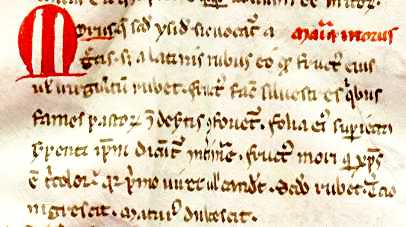Script Type : minuscule
Script Family : Gothic
Date : This example is from the 14th century.
Location :This example is from Italy.
Function : Book hand, but very small and simplified for a book for private study.


























Distinctive letters : The first point to note is that this is a very tiny script. It is a form of Gothic rotunda, but simplified in its letter forms and almost semi-cursive. That is, the letter forms are Gothic but they tend to run together in a somewhat fluid way in places. The book from which it comes is not a lectern book or display volume, but a work for close private study and the writing is tiny, heavily abbreviated and dense.
Most of the letters are of relatively standard Gothic form, although a exists only in the simple, single chambered form. The letter r is variable, sometimes having the standard Gothic form but also existing in an open form, as well as the simplified version that resembles a z. The curly form of s that occurs at the ends of words is not short, but looks like a long s with a kink in the tail.
The letters u and v are identical, and it would be expected that i and j would be as well, but I could not find an example of a j. The letter i is sometimes dotted with a fine diagonal slash, but only when it is necessary to differentiate it from other letters with minims.
There are no examples of k, w or z.
An abbreviation for the letter combination ser, as seen in the word desertis in the middle of the fourth line, or in serpenti at the beginning of the fifth line, is really a ligature, despite the fact that these were supposed to have been banished from sensible writing centuries beforehand.
This is a difficult piece of writing. This bit is about how the Virgin Mary is like a mulberry tree (Truly!). Pass the cursor slowly over the example above to see what can be read. For some background information and a limited paleography exercise, this will be provided, soon I hope. I do not guarantee a proper translation, but we may find out why the Virgin Mary is like a mulberry tree and Christ is like its ripening fruit.
Paleography
exercises using Flash![]()
Requires at least the Flash 5 plugin
If you are looking at this page without frames, there is more information about medieval writing to be found by going to the home page (framed) or the site map (no frames).